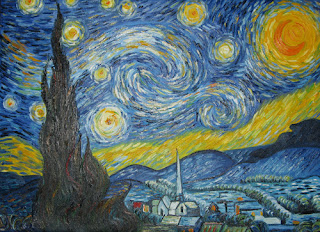Vincent ponders love and finds that he is filled with infinite glory,
and a swirl of stars a-borning.
I love this world so much.
The crumbling brick walls hung with reddened ivy,
swollen rivers and dust-filled wind—
the hunger to eat, the hunger to know.
To be in this world is to be hungry:
wanting more, wanting stars.
Angels could not be more in love
than I am in love
because love holds loss
and angels haven’t lost so much as a key.
Hungry humans lose everything:
every sustaining note of music fades.
We stand hollowed on a brick-heap
with reddened ivy clinging to our legs;
swollen eyes stung by a dust-filled wind.
To be human is to look up,
alone at last—
into a starry night,
praying that the connection we can’t quite touch
is the same as the hunger we can’t quite fill.
To be human is to be in love—
in love with everything
we know how to lose.
Rhonda Palmer
Vincent Willem van Gogh 30 March 1853 – 29 July 1890) was a Dutch post-Impressionist painter whose work had a far-reaching influence on 20th century art for its vivid colors and emotional impact. He suffered from anxiety and increasingly frequent bouts of mental illness throughout his life and died, largely unknown, at the age of 37 from a self-inflicted gunshot wound.
Little appreciated during his lifetime, his fame grew in the years after his death. Today, he is widely regarded as one of history's greatest painters and an important contributor to the foundations of modern art. Van Gogh did not begin painting until his late twenties, and most of his best-known works were produced during his final two years. He produced more than 2,000 artworks, consisting of around 900 paintings and 1,100 drawings and sketches. Today many of his pieces—including his numerous self portraits, landscapes, portraits and sunflowers—are among the world's most recognizable works of art. (from Wikipedia)

Your words make my tears ache.
ReplyDelete